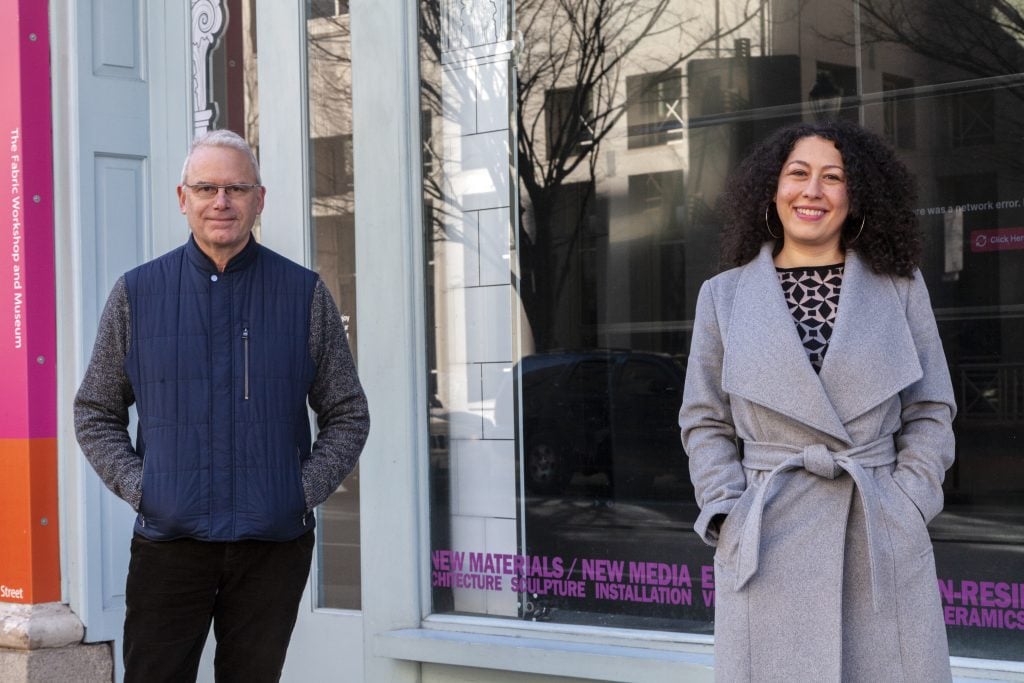Op-Ed
We’re a Group of Museum Directors Who Pooled Resources During the Pandemic. Here’s Why Others Should Consider Doing the Same
It's clear that there is no going back to "normal."

It's clear that there is no going back to "normal."

Harry Philbrick &
Christina Vassallo

Museums are traditionally very good at telling, but not very good at listening. This is obvious not only in the ways museums are often removed from the public they’re meant to serve, but in the ways they’re distant from each other. Yet unexpectedly, the pandemic has afforded museums and arts organizations all kinds of opportunities to close some of that distance, and the results have us rethinking what’s possible.
Last spring, as we at the Fabric Workshop and Museum and Philadelphia Contemporary began to realize how deeply the COVID-19 shutdown would hit us, we gathered with the directors of four additional mid-sized visual arts nonprofits in Philadelphia to develop a joint initiative. At first, we focused on group fundraising to mitigate lost revenue, but those conversations quickly led us to something greater: the opportunity to really listen and learn from one another.
The original six institutions—the African American Museum in Philadelphia, Asian Arts Initiative, Taller Puertorriqueño, the Woodmere Museum of Art, plus the Fabric Workshop and Museum and Philadelphia Contemporary—are spread across the city, with vastly different histories and missions. While we share operating structures and scale, what connects us more deeply is a fundamental commitment to supporting living artists and building communities through the arts. Our alliance goes by a (slightly clunky) name: the Philadelphia Collaborative Arts Consortium, or PHL CAC for short.
After much discussion, we developed structures to jointly fundraise and equitably disperse proceeds between us relative to budget size. More importantly, we learned about each other and the audiences we individually serve. We committed to the concept that we could advance arts leadership in this city by sharing knowledge, expertise, and contacts, and that we all want our varied communities to become more deeply connected to other organizations.
One early programmatic partnership was a clear success. Two of our institutions partnered on a live online event marrying Philadelphia Contemporary’s spoken word and music podcast, Love Jawns, with the Fabric Workshop and Museum’s exhibition of new artwork by Jonathan Lyndon Chase, “Big Wash.” The result was more than either institution could have created on its own, and each enjoyed record attendance for an online event. Another mini-collaboration between the Fabric Workshop and Museum and the Woodmere Museum of Art based on Chase’s exhibition is in progress as a joint social media experiment in audience building. Home runs.
But then we struck out. Initial attempts to conceive a six-way programmatic partnership led to Asian Arts Initiative determining that its community-based model would be impossible to align with the programming needs of five other organizations. While we remain close with the organization and other forms of partnerships with them are in the works, our structure wasn’t right for them at this time. AAI’s withdrawal was a setback that brought home the challenges of collaboration among such uniquely defined partners.
Yet we remain committed to growing and evolving our consortium. Following the exit of Asian Arts Initiative, the five remaining PHL CAC members did some soul searching and devised a process of brainstorming and relationship-building among our staff, with the goal of having initiatives organically bubble up from the collective creative trust. The intent is to figure out ways to serve all our communities (likely online to start) and, eventually, to form a young friends’ group to develop the next generation of contemporary art enthusiasts in Philadelphia. This goal of sharing audiences would likely never have become a reality before the great disruption of the pandemic.
Members of our group that have traditionally focused on distinct audiences are learning from one another. These lessons are applicable across the arts. They may even be essential to the survival of many arts organizations. Just as staffing and fundraising have been deeply impacted by the pandemic, so have audiences’ needs and expectations. It will be through partnerships like ours that arts organizations can share resources, spark creative production, and lower costs. It is by listening—to each other, to our audiences, to our communities—that we will learn what kinds of programming works, how we can best offer it, and how we can sustain it.
The rethinking of business models that all arts organizations are undertaking must lead to new paths forward; we are never going back to “normal.” This is a good thing, given museums’ traditional relationships with diverse audiences. To sharpen the listening skills of the field at large, we urge other organizations to work with each other to develop this kind of transparency, step out of their silos, and listen to learn from their communities—even, and especially, when it’s hard.
Harry Philbrick and Christina Vassallo are the heads of Philadelphia Contemporary and the Fabric Workshop and Museum, respectively.